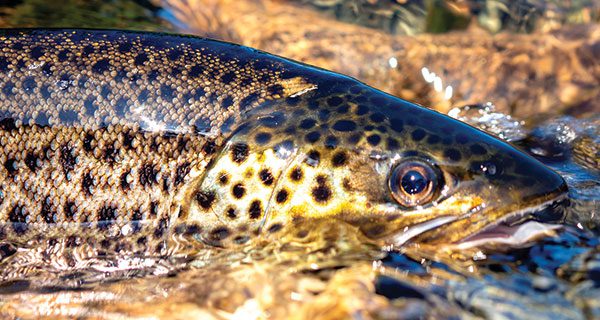What I am about to describe may be a little “off-putting” to some and downright disgusting to others. As I am beginning my forty-eighth-year of fly fishing, mostly in my beloved Smoky Mountains, I am still not at the “well it’s just good to be out” mentality. No, to me it is STILL about the fish. If I catch a below average number of trout, and I won’t share that number, it wasn’t a good day, with the caveat that I may have been “hunting” for trophy sized wild browns. Then, the numbers can slide a little.
On a recent drive to Nashville for business, I took the time to listen to some podcasts. I’m not a dedicated fan of podcasts. Most have too much fluff, or too little information worth my attention. An exception to that is the Orvis podcast with Tom Rosenbauer. I like the “fly-box” where questions are asked, a few occasionally grabbing my attention. On other podcasts, I have heard my name before, yes, my ears did burn, but nothing bad. Tom was answering a question about the impact of waste water treatment plants. The question was whether they were good or bad for the stream. Of course, my thought landed squarely with the fish and what, if any, impact it had on my catching them.
Tom went on to say they can be good or bad. Good, if there exists bad bacteria in the stream and the water coming out of the treatment facility can be cleaner than the water in the stream. In some cases, the stream can be more fertile downstream of the discharge as the water coming out of the treatment facility may promote greater insect life that trout and other fish feed upon. On the flipside, the treated water can contain chlorine or other components which are detrimental to stream insects and thus worsen the fishing. For the most part, I think today’s water treatment plants are much better in the past when they essentially removed the solid waste, releasing the rest to pollute the stream.
Incidentally, I do remember reading an article a few years back how some fish become addicted to drugs that are flushed down toilets making their way through the treatment facilities to the fish. There’s always a downside to everything it seems unless it makes the fishing better. One thing I DO NOT like is the smell of a water treatment plant. Even the water coming out and pouring into the stream has a bad odor. That’s the definite downside. But the things we do for and tolerate in our ever-evolving pursuit of fish.
A few winters ago, I was fishing a tailwater river that has a waste water discharge alongside the road following the river. The pipe actually flows under the road and directly into the river. I was fishing with a friend just over from the facility when I heard the noise signifying the release of water. So, here’s the scenario as it played out.
Immediately, from wading the rapids in the middle of the river I pulled a Usain Bolt or Carl Lewis, for the older sports fans, sprinting over to the edge of the pipe outflow. Having positioned myself adjacent to the outflow and about thirty to forty yards below the release pipe I began to cast into the smelly water. What happened the next fifteen minutes or so of release time was nothing short of amazing! Having gone from catching the usual 12 to 14 inch trout to now catching 18 to 22 inchers was better than what I expected but definitely hoped for. It was like a brief mother of all hatches in how the fish reacted. No, they weren’t hitting dries but were attacking my wooly-booger with reckless abandon on nearly every cast.
Why the sudden feeding frenzy asked my fishing buddy who witnessed my sprint in waders and subsequent action. And most importantly, how did I know? Especially since I rarely fish the river. Always trying to apply my experience to the problem-solving challenge of getting fish to bite, I explained that I knew from my stream thermometer the river water was a nice fifty-two degrees. Nice for late November and I figured the waste water flowing out of the pipe would be warmer. How much warmer I didn’t know and didn’t check with my stream thermometer, but I could tell it was a little warmer. A temperature change by a few degrees can have a huge impact on how fish bite. The same can be said for cool spring water entering a summertime river where the water is borderline warm for fish.
Of course, there’s always another possible answer. Maybe those experienced trout knew where to get relief for their sore jaws in the heavily fished water and knew that relief came in the form of flushed pain meds. But I digress….
Regardless, keen eye, nose, and ears for the surroundings is not only a necessary trait of a good fishermen when on the water but can also literally save your life. If you’ve ever had to sprint in waders when the sound of the flowing water suddenly gets louder, while fishing below a dam (another cause for the Bolt/Lewis dash to dry land), you know what I’m talking about. Those same senses used to sense a change in the water temperature can signal an opportunity, some even atypical, for amazing fishing.
Naturally occurring opportunities such as sudden rainstorms often result in a change in water conditions, namely the water temperature and clarity ramping up the feeding activity. Dingy water makes it harder to be seen by the wily old browns, plus more food is washed into the stream, potentially creating a feeding frenzy similar to that seen during Shark Week. Not all opportunities are natural. Some are manmade of the less aesthetic variety. It may not have been “good to be out” in the waste water, but it was sure fun catching those fish!
